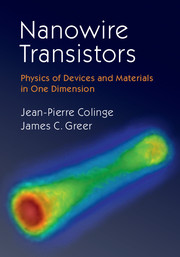Book contents
- Frontmatter
- Dedication
- Contents
- Preface
- 1 Introduction
- 2 Multigate and Nanowire Transistors
- 3 Synthesis and Fabrication of Semiconductor Nanowires
- 4 Quantum Mechanics in One Dimension
- 5 Nanowire Electronic Structure
- 6 Charge Transport in Quasi-1d Nanostructures
- 7 Nanowire Transistor Circuits
- Index
- References
6 - Charge Transport in Quasi-1d Nanostructures
Published online by Cambridge University Press: 05 April 2016
- Frontmatter
- Dedication
- Contents
- Preface
- 1 Introduction
- 2 Multigate and Nanowire Transistors
- 3 Synthesis and Fabrication of Semiconductor Nanowires
- 4 Quantum Mechanics in One Dimension
- 5 Nanowire Electronic Structure
- 6 Charge Transport in Quasi-1d Nanostructures
- 7 Nanowire Transistor Circuits
- Index
- References
Summary
Overview
This chapter introduces how electron and hole currents can be described in nanostructures with emphasis on how quantum mechanical effects arise when treating charge transport in small cross-section semiconductor nanowires. Discussion of the voltage sources that drive electrical behavior alongside the relationship of voltage to current in quantum mechanical systems leads to the property of conductance quantization. An overview of the relationship of charge carriers (electron, hole) scattering to mobility and the relationship to mean free paths is introduced. Transistor channels with length scales below or comparable to the mean free paths for electrons or holes are considered leading to quasi-ballistic transport. In the quasi-ballistic regime only a few scattering events can occur resulting in macroscopic properties such as mobility, diffusion, and drift velocity becoming inapplicable and charge carrier transport is no longer described by classical drift and diffusion mechanisms. The chapter concludes with an introduction to Green's function approaches, which are suitable for describing charge transport in the scattering regimes ranging from purely ballistic, to quasi-ballistic, to ohmic conduction.
Voltage sources
Semi-classical description
Before embarking on a discussion on how to calculate electron and hole currents in nanowire structures, it is useful to consider the physical description of a voltage source. A non-equilibrium condition is required to be built up across the nanowire or “device” region to provide the charge imbalance that gives rise to electric current. To understand how a battery or power supply acts to create such a non-equilibrium condition, the result of a voltage applied by a battery between two disconnected (open circuit) electrodes is examined. Within a battery, electrochemical cells provide a potential difference that results in a deficiency of electrons on the cathode (positive terminal) and an excess of charge on the anode (negative terminal). Figure 6.1 provides a simple depiction of a battery connected to two electrodes shown as metal regions with wires connecting them to a battery or other voltage source. It is assumed the wires are ideal conductors and the electrodes are metallic. Hence in a cathode electrons are pulled away from the metal electrode leaving a net positive charge behind, whereas an excess of negative charge is built on the anode.
- Type
- Chapter
- Information
- Nanowire TransistorsPhysics of Devices and Materials in One Dimension, pp. 167 - 220Publisher: Cambridge University PressPrint publication year: 2016



